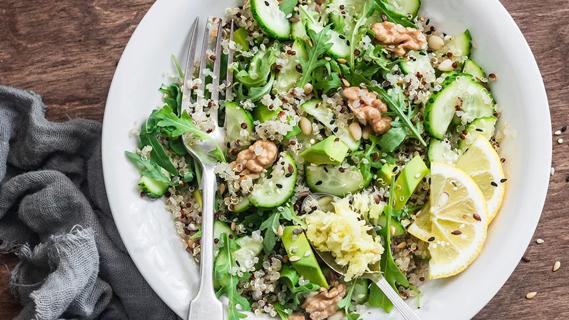When it comes to getting proper nutrition, your assigned sex can play a role — but there’s more to it than that

Anyone who’s ever scanned the vitamin aisle at their local drugstore has seen the labels. The ones that say a certain supplement is “formulated for women.” Or “made for men.” If you go a step further and inspect those labels, you’ll spot some differences.
Advertisement
Cleveland Clinic is a non-profit academic medical center. Advertising on our site helps support our mission. We do not endorse non-Cleveland Clinic products or services. Policy
Vitamins labeled for women tend to contain certain nutrients in higher numbers. That includes ones like iron, folate and biotin. Vitamins labeled for men contain higher doses of some other nutrients, like pantothenic acid (vitamin B5) and magnesium.
And it’s not just vitamin bottles. Differences in nutritional recommendations abound.
For example, the U.S. Food and Drug Administration (FDA) suggests that moderately active males between the ages of 31 and 35 should consume 2,600 calories in a day. Moderately active females in that same age range are advised to consume 2,000 calories.
But ... why? Is your sex assigned at birth the key to knowing exactly how much of which nutrients you need to stay healthy?
Hardly, says registered dietitian Sereen Zawahri Krasuna, RD, LD. “For some people, your sex can be used as one of several elements to look at, but it’s not necessarily a pinpoint accurate reflection of your individual nutritional needs. It’s not that cut-and-dry. There are a lot of considerations to take into account.”
Zawahri Krasuna explains what your sex assigned at birth has to do with nutrition and shares advice for how you can make sure you’re getting the proper nutrition for you.
Advertisement
Some nutrient recommendations change based on your assigned sex. Consider these recommended dietary allowances (RDAs) for just a couple key nutrients:
Vitamin A
Magnesium
Iron
Potassium
And the list goes on. Tons of nutrients in our diets have different RDAs depending on your sex assigned at birth.
Zawahri Krasuna agrees that national recommendations are a good starting point for building a healthy diet. But they’re not necessarily hard-and-fast rules that are guaranteed to be best for everyone.
That’s in part because these numbers are based on scientific understandings at the population level. Not tailored to each individual person.
But what does that mean?
“Nutritional recommendations are based on scientific studies of large groups of people and categorizing them based on things like your sex assigned at birth, age ranges and whether they’re pregnant or breastfeeding,” Zawahri Krasuna explains.
“Those study findings get boiled down to reasonable recommendations based on the big picture of what tends to work for those groups. It doesn’t necessarily mean that every male needs X and every female needs Y. It’s a general recommendation based on what we know to be true for these groups.”
It’s a good starting point. But your sex isn’t the only consideration for building a healthy, personalized diet. Zawahri Krasuna shares some advice about why certain people may have different nutritional needs from others.
Nutritional recommendations that vary based on assigned sex are, in part, based on the standard that males tend to be more muscular in nature than females. As a whole, male bodies tend to have more muscle mass than female bodies. That’s a natural, biologically driven standard, though there are plenty of people who are the exception to that rule.
And muscle matters when it comes to your metabolism.
“When you have more muscle, your body is able to convert food into energy at a faster rate,” Zawahri Krasuna states.
That’s true regardless of your assigned sex. Your body composition is based on a number of factors. Your sex assigned at birth does make a difference when it comes to the hormones your body makes. But so, too, does your lifestyle and your genetic predisposition to a certain body type. Not to mention any health conditions you live with that impact how your body breaks down food into fuel.
Regardless of your assigned sex, muscle eats up more calories even when you’re at rest. So, people with a higher muscle mass may need more calories and other nutrients than national recommendations suggest.
Advertisement
Hormones like estrogen play a big role in how female bodies create and metabolize nutrients. And when you enter menopause, your estrogen levels drop. That can leave you vulnerable to certain health conditions.
“Following menopause, you’re at a bigger risk for conditions like osteoporosis, for example, because estrogen helps to keep your bones strong and healthy,” Zawahri Krasuna shares.
Changes in estrogen is one reason why you’ll see recommendations for some nutrient changes for females older than 50.
Consider these recommended dietary allowances for calcium:
The goals you have for your health will change what you should eat.
For example, if you’re looking to lose weight, you’ll want to up your intake of protein and fiber, maybe even more than the standard recommendation based on your sex assigned at birth. That’s because protein and fiber will help you stay fuller longer. That can help curb your appetite and limit mindless eating.
Your health status and the medications you take can also impact how much of certain nutrients you should have in your diet.
If you're on a blood-thinning medication, like warfarin (Coumadin®), for example, your healthcare provider may recommend being consistent with your intake of vitamin K. That’s because vitamin K can raise your risk for blood clots while on warfarin.
Advertisement
Or if you’re living with obesity (a body mass index of 30 or greater), you may be advised to take higher doses of vitamin D supplements than are typically recommended.
It’s important to recognize that, for now at least, nutrition recommendations reflect scientists’ best knowledge for people assigned male at birth (AMAB) and people assigned female at birth (AFAB).
So, when you see that “men” ages 19 to 30 need 34 grams of fiber in their diet and “women” that age need 28 grams, “men” is really based on studies of cisgender males. And “women” is based on research on cisgender females. That’s true of any RDA values.
“There have been a few very small studies on nutrition needs for people undergoing gender affirmation treatment, but they’ve been small in scale and not replicated in larger research,” Zawahri Krasuna adds. “I recommend talking with your healthcare team about the proper nutrition for you, particularly if you’re taking any medication.”
So, if it’s not as easy as finding your age and assigned sex on a chart to pinpoint your exact nutritional needs, what can you do to make sure your diet is on track?
“It’s always going to come back to eating in a well-balanced way,” Zawahri Krasuna advises. “If you’re basing your eating on fruits, vegetables, lean proteins and unsaturated fats, you can be confident you’re almost certainly getting the nutrition your body needs.”
Advertisement
In other words, most of us don’t have to be all that laser-focused on exact numbers of grams of this and micrograms of that and the role of your assigned sex when it comes to getting good nutrition. Your best bet for getting the nutrition that keeps your body healthy and satisfied is something like the Mediterranean diet.
And if you have specific questions about nutritional needs for your health conditions or your body’s needs, working with a registered dietitian can help you find strategies to best take care of your health.
Learn more about our editorial process.
Advertisement

Ground flaxseed is full of heart-healthy omega-3s, antioxidants and fiber, and easy to add to just about any recipe

From meat to beans, we’ve got some ideas to help you create the perfect-for-you chili recipe

Only 130 calories per serving, this dessert deserves your attention

Plan ahead, bring a cooler when possible and don’t forget the water!

A delicious twist on grilling

A cool, refreshing and satisfying salad!

Whip up this dish for a fun and healthy appetizer

Type 2 diabetes isn’t inevitable with these dietary changes

Applying a hot or cold compress can help with pain